This incredible beast of a bird ambled around North America during the Eocene. I was so happy to be commissioned to illustrate this bird in its paleoenvironment, especially since I was given the challenge to display features that hadn’t really been illustrated before.
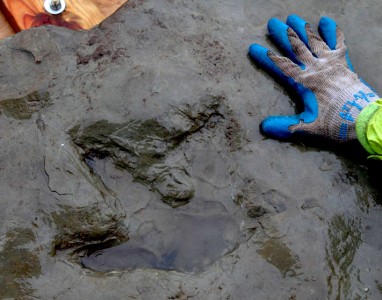 The impetus for this was that in Whatcom county in 2009, there was a large landslide that revealed sandstone slabs from the Eocene. Incredibly, this was the first time that tracks of a Diatryma had been revealed to us through geologic time! There have been many fossils uncovered, but what amazing new angle that these tracks showed paleontologists was that this lumbering giant’s “talons” left no mark in the soft sand as it passed by that day 56 million years ago. What does this mean? It suggests that the bird indeed had reduced claws. What does that mean? Being that this fossil lacked a hooked beak, (as almost all living birds of prey that hunt or scavenge have), and the fact that its claws didn’t depress in the soft sand lead many to believe that it is further confirmation it was a peaceful foliverous/frugivorous/vegetarian animal. (Admit it, you viscerally want a 7 foot tall bird to be a terrifying carnivore….admit it!)
The impetus for this was that in Whatcom county in 2009, there was a large landslide that revealed sandstone slabs from the Eocene. Incredibly, this was the first time that tracks of a Diatryma had been revealed to us through geologic time! There have been many fossils uncovered, but what amazing new angle that these tracks showed paleontologists was that this lumbering giant’s “talons” left no mark in the soft sand as it passed by that day 56 million years ago. What does this mean? It suggests that the bird indeed had reduced claws. What does that mean? Being that this fossil lacked a hooked beak, (as almost all living birds of prey that hunt or scavenge have), and the fact that its claws didn’t depress in the soft sand lead many to believe that it is further confirmation it was a peaceful foliverous/frugivorous/vegetarian animal. (Admit it, you viscerally want a 7 foot tall bird to be a terrifying carnivore….admit it!)
With the closing of the M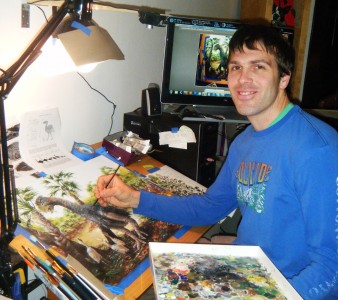 esozioc and the death of all of the beautiful dinosaurs, there was a huge void left in lifestyle niches that were wide open to exploit for whatever animals made it through the extinction. Filling this was our fair Diatryma that stood at a mighty 7 feet tall, and weighed perhaps 400 pounds. What is very striking is the massive scale of its head. It seems vastly overbuilt for the purposes of clipping vegetation but between perhaps cracking really hard things and sexual selection, it sported a beak that was about a foot long, very tall, and very thick. Compare that with any other bird head/beak living or extinct- the elephant bird of Madagascar, moas, cassowaries, ostriches…their heads and beaks are all much smaller even if the birds themselves are larger or taller.
esozioc and the death of all of the beautiful dinosaurs, there was a huge void left in lifestyle niches that were wide open to exploit for whatever animals made it through the extinction. Filling this was our fair Diatryma that stood at a mighty 7 feet tall, and weighed perhaps 400 pounds. What is very striking is the massive scale of its head. It seems vastly overbuilt for the purposes of clipping vegetation but between perhaps cracking really hard things and sexual selection, it sported a beak that was about a foot long, very tall, and very thick. Compare that with any other bird head/beak living or extinct- the elephant bird of Madagascar, moas, cassowaries, ostriches…their heads and beaks are all much smaller even if the birds themselves are larger or taller.
Even with all the data we have distilled about this animal and its habitat, I was still left with many decisions to make. What kind of plumage? more like an ostrich or a kiwi or a rail? What colors would the plumage have? Should it carry up its neck and cover its head? How many chicks? What setting should they be in?
I did a lot of research on the many anatomical and other details I needed to resolve before starting, but it was a exhilirating project that I hope to do many more of. I love extinct animals, the early Cenezoic, Braeburn apples, and fossil reconstruction….3 out of 4 isn’t bad!
I did many sketches of the angles I could show it from, but in the end chose one, transferred to my canvas, then got cracking on the painting. I used all acrylic paint, and may even take it a little further digitally. I also set up a web cam for time lapse video capture! Soon when I have some more time to learn the editing software, I will be able to post a 2ish minute movie of the whole process. I can’t wait!
Let me know any questions you have about the process, what you like or what you feel should be different….in fossil reconstruction no-one is 100% right!

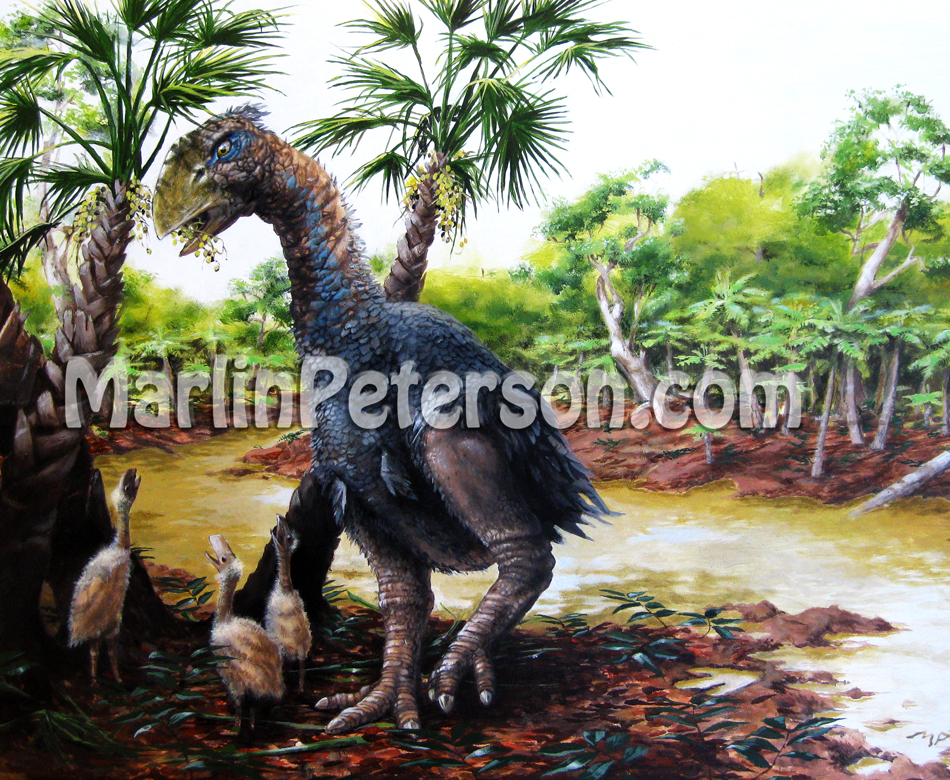
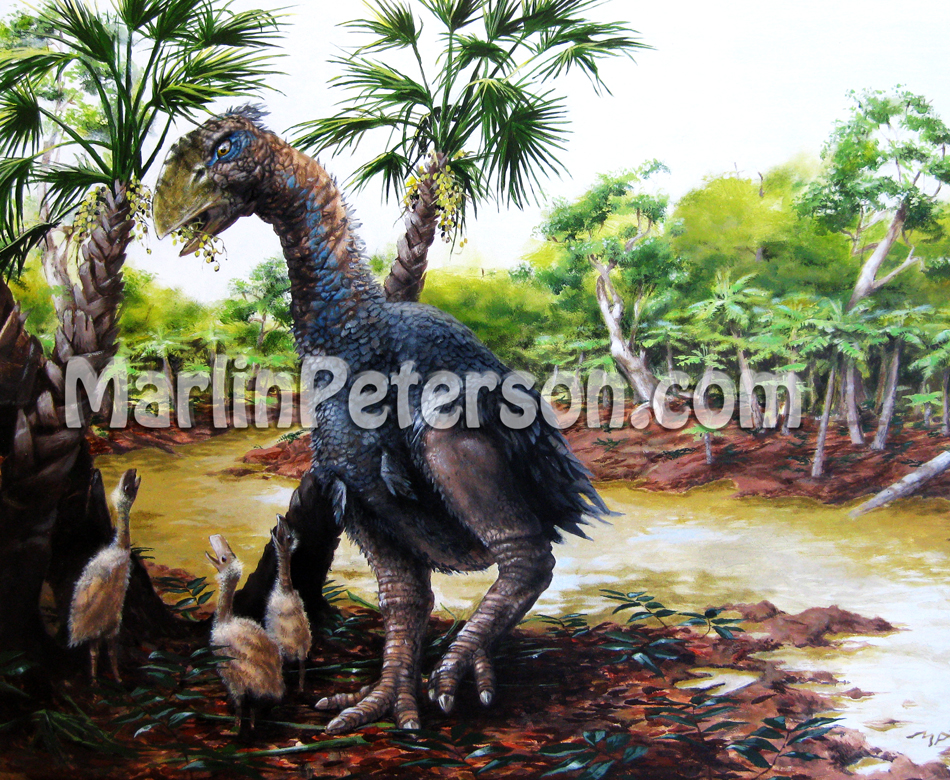
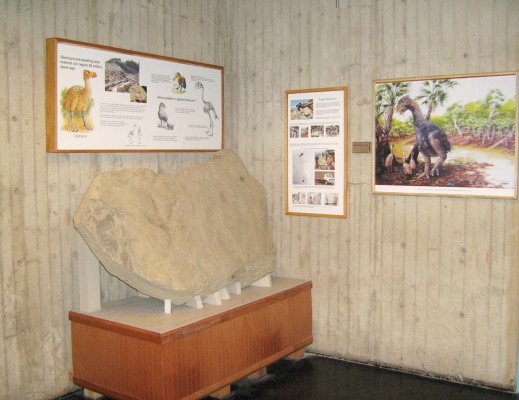
that is a great painting! how many time did it take to be all done? my younger son, Felipe (4 yrs and a half) will love it. he is slepping now (almost 11:00 pm down here in Rio, Brazil). I will show him by the morning.
see ya
joao
Genius!!! There’s such a real sense of being there in this one. Powerful, brilliantly painted work, monsieur!
***big round of applause***
Noel
I think Walt Disney needs to hire you — Marlin Peterson – 2012 Academy Award for special effects!!!!
Yes!
Very excellent!!!!
It’s really amazing how this huge dinosaurs lived on earth for many years and how they herbivors lived with the omnivors dinosaurs. If I do have a chance to see them, I want to see huge this huge dinosaurs as well.
It’s sad that we didn’t had the chance to see these awesome creatures alive. It’s almost unbelievable how this massive creatures live on earth thousands of years ago…
Omnivores and Herbivores got along fine….why can’t we? uh wait, they died out….I suppose we could find better role models….
I hope we can all see some huge dinosaurs one day….if the Jurassic Park thing really happens, but I am doubtful. we might have to settle for a wooly mammoth birthed by an elephant
Ya. I am sort of amazed that all the flightless birds haven’t yet been killed off. I suppose for lumbering vegetarians we have rails, and for badass huge birds, my favorite would certainly be the cassowary.
Evidence seems to point to the Diatryma having gone extinct in the tens of millions of years ago, rather than the thousands ago…but humans weren’t there so we don’t know!
The fossil hunt carries on!
thanks for the comment!
huge dinosaurs bird ambled it’s become only a folks just in a thousands of year been fast.
This bird is haunting my dreams. Vegetarian??!! I can almost feel it pulling at my innards and crushing my skull with its’ ridiculously over-sized beak as I write. Me being the Eocene epoch, humanoid version of the tofurkey, if you will. If you were chilling riverside and one of these monstrosities approached you, I ask you…would you keep your cool and stay put, thinking to yourself – don’t be such a wuss, it eats coconuts, not people! Not a chance! I’m running like hell! I got chased by a Rhea and almost pissed my pants. This thing is at least a thousand times bigger…
Kick ass drawing dude!!
Wow! I like your post so nice images. Thanks for creating this site and also the video.
Cheers Brian! I do it for people like you…and diatrymas like the one I painted. I hate to have to see those go extinct. Thanks for leaving a comment!
This is what we call “talent”. You did it easily and wonderfully. Thanks a bunch!:)
hey Barbara, thanks for the kind comment! I wouldn’t say it was so easy, but I like how it turned out. I am pretty excited for my next one in this series, so pay attention for that coming soon…
wow! so amazing you paint that kind of animal, very great, it took many hours to finished .
@Marlin Peterson: Thank you so much! I was so excited to your next series.
I hope to paint many other fantastic animals from the early Cenozoic…they are equally cool to dinosaurs!
Sorry, late to the party, but Holy Big Bird! Your description of the process required to fill in the blanks sounds fascinating. To think that thing was cruising the cnuts, perhaps near burnout or DBD or… where is this landslide?
wow Marlin! That’s is seriously amazing! I can only draw stick figures (and very poorly I might add) so I bow down to you and your talent 🙂 Hope you and Chrissy had an awesome Christmas XOXOXO